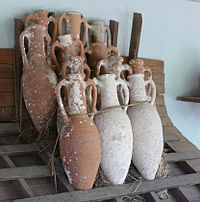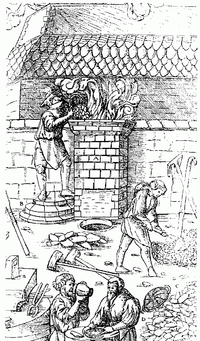
New insights into agriculture in northwestern France from the Bronze Age to the Late Iron Age: a weed ecological approach
Sign Up to like & getrecommendations! Published in 2021 at "Vegetation History and Archaeobotany"
DOI: 10.1007/s00334-020-00817-8
Abstract: New plant macrofossil studies in northwestern France enable a better insight into agriculture through the Bronze and Iron Age. Most of the previous analyses, carried out in Calvados (Normandy) on Late Iron Age dwellings, suggested… read more here.
Keywords: iron age; age; northwestern france; late iron ... See more keywords

Waste disposal in late Iron Age and early Roman Silchester: A geochemical comparison of pits, post holes, ditches and wells in Insula IX
Sign Up to like & getrecommendations! Published in 2017 at "Journal of Archaeological Science: Reports"
DOI: 10.1016/j.jasrep.2017.06.044
Abstract: Bulk chemical analysis was undertaken on samples taken from 143 negative features (wells, pits, post-holes, cess pits and ditches) across the area of excavation at Silchester Hampshire in order to help us understand the disposal… read more here.
Keywords: post holes; pits post; waste; late iron ... See more keywords

Petrographic and neutron activation analysis of Late Iron Age amphorae from the south western Iberian Peninsula
Sign Up to like & getrecommendations! Published in 2020 at "Journal of Archaeological Science: Reports"
DOI: 10.1016/j.jasrep.2020.102598
Abstract: Abstract This paper presents the study of two sets of Late Iron Age amphorae from the south western Iberian Peninsula through petrographic and Neutron Activation analysis. The first assemblage includes Turdetanian amphorae from the Guadalquivir… read more here.
Keywords: south western; amphorae south; age amphorae; late iron ... See more keywords

Agricultural innovations at a Late Iron Age oppidum: Archaeobotanical evidence for flax, food and fodder from Calleva Atrebatum, UK
Sign Up to like & getrecommendations! Published in 2017 at "Quaternary International"
DOI: 10.1016/j.quaint.2016.02.058
Abstract: Abstract The development of oppida in the late first millennium BC across north-western Europe represents a major change in settlement form and social organisation. The construction of extensive earthwork systems, the presence of nucleated settlement… read more here.
Keywords: iron age; late iron; agricultural innovations; evidence ... See more keywords

Bird exploitation in Viljandi (Estonia) from the Late Iron Age to the early modern period (c. 950–1700)
Sign Up to like & getrecommendations! Published in 2020 at "Quaternary International"
DOI: 10.1016/j.quaint.2020.07.018
Abstract: Abstract This paper examines archaeological bird bones from Viljandi – one of the strongest centres in prehistoric and medieval Estonia – and covers material from the Late Iron Age to Early Modern Period, c. 950–1700.… read more here.
Keywords: bird; period; late iron; early modern ... See more keywords

Colin Haselgrove (ed.). Cartimandua's capital? The late Iron Age royal site at Stanwick, North Yorkshire, fieldwork and analysis 1981–2011 (Research Report 175). 2016. xxviv+530 pages, numerous colour and bw 978-1-902771-98-4 hardback £40.
Sign Up to like & getrecommendations! Published in 2017 at "Antiquity"
DOI: 10.15184/aqy.2017.10
Abstract: Yao’s book is eloquently written and well produced, furnishing a variety of maps, photographs and drawings of sites and artefacts. The concluding chapter gives us important ways to frame material traces against a backdrop of… read more here.
Keywords: haselgrove cartimandua; cartimandua capital; capital late; late iron ... See more keywords